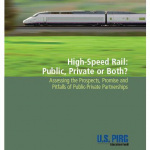High-Speed Rail: Public, Private or Both?
Assessing the Prospects, Promise and Pitfalls of Public-Private Partnerships
Private sector companies are likely to play a major role in the construction of high-speed rail lines in the United States. Public-private partnerships – or “PPPs” – have come to play an important role in the construction of high-speed rail lines around the world. The experience with high-speed rail PPPs, however, has been mixed. While PPP arrangements have brought private capital and expertise to the task of building high-speed rail, PPPs have also resulted in cost overruns, government bailouts, and other serious problems for the public. America must learn from these experiences and pursue PPPs only in keeping with key principles designed to protect the public interest.
Downloads
U.S. PIRG

Private sector companies are likely to play a major role in the construction of high-speed rail lines in the United States. Public-private partnerships – or “PPPs” – have come to play an important role in the construction of high-speed rail lines around the world.
The experience with high-speed rail PPPs, however, has been mixed. While PPP arrangements have brought private capital and expertise to the task of building high-speed rail, PPPs have also resulted in cost overruns, government bailouts, and other serious problems for the public. America must learn from these experiences and pursue PPPs only in keeping with key principles designed to protect the public interest.
All high-speed rail public-private partnerships require substantial public investment. In fact, no modern high-speed rail line has ever been built with only private capital. In several recent and current European high-speed rail PPPs, the public sector has been responsible for more than half the capital cost of the high-speed rail line.
Public-private rail partnerships have the potential to tap private capital, expertise, technology and economies of scale, and can also help mitigate the risk of high-speed rail projects to taxpayers. However, PPPs also come with a number of risks and costs, including:
• Higher costs for capital, as well as costs related to the profits paid to private shareholders.
• Heightened risk for the public once a project has begun, due to the ability of private-sector actors to hold projects hostage and demand increased subsidies or other concessions from government.
• The costs of hiring and retaining the lawyers, financial experts and engineers needed to protect the public interest in the negotiation of PPP agreements and to enforce those agreements over time.
• Loss of control over the operation of the high-speed rail line, which can result in important transportation assets being operated primarily to boost private profit rather than best advance public needs.
• Delays in the early stages of a project, as government and private partners engage in the difficult and complex task of negotiating PPP agreements.
High-speed rail PPPs and efforts toward rail privatization abroad have a mixed track record. The report reviews a number of international cases of better and worse cases of contracting in Europe and Asia.
Public officials should use a set of common-sense principles to evaluate public-private partnerships – and should refuse to pursue PPPs that do not serve the public interest.
The principles that should guide government’s approach to high-speed rail PPPs are:
1) Governments must only pursue PPPs for the “right” reasons, such as the ability to deliver a public project for lower price or with higher quality – rather than use PPPs to avoid budgetary discipline or compliance with governmental standards.
2) PPPs must deliver added value for the taxpayer, as measured by a comprehensive test that includes all the relevant costs of a high-speed rail project.
3) PPPs must align private sector incentives with public sector goals, ensuring that private sector partners experience penalties and rewards that forward the public’s interest.
4) PPPs must only be pursued where ample competition exists for the service being put out for bid.
5) PPPs must only be pursued by competent, well-prepared governments with the ability to defend the public interest in contract negotiations, monitoring and contract enforcement.
6) There must be clear public accountability in PPP projects, with one government agency responsible for oversight and holding contractors accountable for performance.
7) The public must retain control over key transportation-system decisions.
8) PPP projects must not impose unreasonable limitations on future government action.
9) PPP contracts should be of reasonable length.
10) There must be complete transparency in the PPP contracting process and in the execution of PPP contracts.
Government agencies considering PPPs should understand that even well-crafted PPPs are not a panacea – and that a strong government commitment to the project is likely necessary to draw productive private investment.
